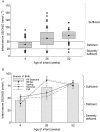Heightened attention to supplementation is needed to improve the vitamin D status of breastfeeding mothers and infants when sunshine exposure is restricted
- PMID: 22708508
- PMCID: PMC3461108
- DOI: 10.1111/j.1740-8709.2012.00422.x
Heightened attention to supplementation is needed to improve the vitamin D status of breastfeeding mothers and infants when sunshine exposure is restricted
Abstract
Although exclusively breastfed infants are at increased risk of vitamin D (vit D) deficiency if vit D supplementation is lacking and sun exposure is limited, assessment of both risk factors in the first year of life is lacking. We evaluated the contribution of vit D intake and sunlight exposure to vit D status in 120 healthy, breastfeeding mother-infant dyads, who were followed up for 1 year. Vitamin D intake and skin sunlight exposure were evaluated using questionnaires. Serum 25-hydroxyvitamin D, parathyroid hormone (PTH) and alkaline phosphatase levels were determined post-natally in mothers at 4 weeks and in infants at 4, 26 and 52 weeks. Vitamin D supplementation was low (<20%) and sunlight exposure was common (93%) in study infants. At 4 weeks, 17% of mothers were vit D deficient (<50 nmol L(-1)) and 49% were insufficient (50-<75 nmol L(-1)), while 18% of infants were severely vit D deficient (<25 nmol L(-1)) and 77% were deficient (<50 nmol L(-1)). At 26 weeks, winter/spring birth season and shorter duration of months of exclusive breastfeeding were protective of vit D deficiency in infants. Vitamin D deficiency in infants decreased to 12% at 52 weeks with sunlight exposure. Serum PTH levels were significantly higher in severely vit D deficient than sufficient infants. Vitamin D deficiency was widespread in early post-partum breastfeeding mothers and infants, and declined to one in eight infants at 52 weeks due mostly to sunshine exposure. When sunlight exposure is limited or restricted, intensified vit D supplementation of breastfeeding mothers and infants is needed to improve vit D status.
Keywords: breastfeeding; infants; mothers; sunlight exposure; vitamin D deficiency.
© 2012 John Wiley & Sons Ltd.
Conflict of interest statement
The authors declare that they have no conflicts of interest.
Figures


References
-
- AAP ( 1999. ) Ultraviolet light: a hazard to children. Committee on Environmental Health . Pediatrics 104 , 328 – 333 . - PubMed
-
- Andiran N. , Yordam N. & Ozon A. ( 2002. ) Risk factors for vitamin D deficiency in breast‐fed newborns and their mothers . Nutrition 18 , 47 – 50 . - PubMed
-
- Barger‐Lux M.J. & Heaney R.P. ( 2002. ) Effects of above average summer sun exposure on serum 25‐hydroxyvitamin D and calcium absorption . The Journal of Clinical Endocrinology and Metabolism 87 , 4952 – 4956 . - PubMed
-
- Bhalala U. , Desai M. , Parekh P. , Mokal R. & Chheda B. ( 2007. ) Subclinical hypovitaminosis D among exclusively breastfed young infants . Indian Pediatrics 44 , 897 – 901 . - PubMed
-
- Bischoff‐Ferrari H.A. , Giovannucci E. , Willett W.C. , Dietrich T. & Dawson‐Hughes B. ( 2006. ) Estimation of optimal serum concentrations of 25‐hydroxyvitamin D for multiple health outcomes . The American Journal of Clinical Nutrition 84 , 18 – 28 . - PubMed

